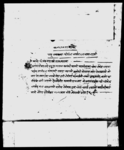A copy of a rukkā presumably of King Surendra appointing Santoṣanātha as abbot of Siddha Bhagavantanātha's monastery (VS 1909)
ID: K_0356_0032
Edited and
translated by Christof Zotter
Created: 2020-09-16;
Last modified: 2020-10-14
For the metadata of the document, click here
The accompanying edition, translation/synopsis and/or commentary are available under the terms of the Creative Commons Attribution-ShareAlike 4.0 International License
Abstract
In the rukkā of which this is a copy the king, who according to the date must have been Surendra, appoints Santoṣanātha as mahanta of Siddha Bhagavantanātha's maṭhas in Dang and Salyan after the previous mahanta, Jagadīśvaranātha (text: Jagato- and Jagatenātha), breached the rule against keeping women in the maṭhas.Diplomatic edition
[1r]
1८४नं•[seal]1[?]1१९०९।१०।११सल्को•2¯¯¯¯¯¯¯¯¯¯¯¯
3डाङ्सल्यानाका•श्रीसीद्ध•भगवंन्तनाथ•कामठवाहाली•
4¯¯¯¯¯¯¯¯¯ ¯¯¯¯¯¯¯¯¯ ¯¯¯¯¯¯¯¯¯ ¯¯¯¯¯¯¯¯¯
5स्वस्तिश्री•मन•माहाराधी•राजकस्यरुक्का•
6आगेसन्तोषनाथके•डाङ्ग••सल्यानाका•मठगांदी•मावसीस्वास्नीनराषनु•भंन्या•वंन्देज•भय़ामा•
7महंन्त•जगतोनाथ•लेस्वास्नी•राषदार•मठगादीलातीगरी•मोगलाना•जांदा•तेसमठगादी•को•
8जगा•तेनाथकानाऊमा•भय़ाको•मोहर•हानी•तीमीलाईमहंन्त्याईगरीवक्स्यौ•आफ्नाषातीरज्मासंग•अ•
9घीदेषि•चली•आय़ाको•रीतवमोजीममठमादरीय़ाकोजगा•कोअसुलतहसील•गरीश्रीसीद्ध
10भगवंन्त•नाथकामठगादी•मानीत्यनैमीत्यक•पुजाभण्डारचलाई•हाम्राजयेमनाईमहंन्त्याई
11जानी•भोगेगर•ईतिसंम्वत१९०९सालमीती•ज्येस्तवदी४रोज६शुभ्म्
Translation
[1r]
no. 841
[seal]2
of the year [VS] 1909/10/11
Appointment, monastery (maṭha) of the venerable SiddhaBhagavantanātha, Dang, Salyana
Hail. [This is] an executive order (rukkā) of the supreme king of great kings.3
Āge: to Santoṣanātha
We have annulled the mohara issued in the name of Jagadīśvaranātha (text: Jagatenātha)4 of that monastic throne [and] granted you the abbotship because, although there is a rule (bandeja) that states: "[he who] sits on the monastic throne of Dang (i.e. in the monastery in Śrīgāũ) [and] Salyan (i.e. in the monastery in Rānāgāũ) shall not keep a woman," Mahanta Jagadīśvaranātha (text: Jagatonātha) kept a woman and, spurning (lātī garī) the monastic throne, went to Moglānā (for muglāna, i.e. Hindusthan). Conceive the abbotship [as yours and] dutifully enjoy [it] according to the customs that have been practised before, collecting the income due on the land registered in the name of the maṭha, conducting the daily and occasional pūjās and observing feasts from the throne of the monastery of the venerable Siddha Bhagavantanātha, and celebrating our triumphs.
Friday, the 4th of the dark fortnight of Jyeṣṭha of the [Vikrama] era year 1909 (1852 CE). Auspiciousness.
Commentary
This rukkā, the only copy of which found in the archives is the one edited here, is remarkable in that it attests to a conflict related to Bhagavantanātha's succession that was seemingly erased from the tradition’s memory. According to the genealogies in the Yogivaṃśāvalī (Naraharinātha n. d.: 77, 78, 89) and other documents (see e.g. K_0469_0033), Jagadīśvaranātha, the mahanta whose name appears in the present document as Jagato- or Jagatenātha, was Bhagavantanātha’s fourth successor. He ascended the throne of the maṭha after the death of his guru Mahanta Lokanātha, and before he passed away he selected his own disciple Khīmānātha as Bhagavantanātha's fifth successor. None of the tradition's own accounts mentions Santoṣanātha. As we know from the archival material, Jagadīśvaranātha's (first) confirmation of abbotship (mahantyāiko lālāmohara)—the mohara that was annulled by the present document—was issued by King Surendra and countersigned by Prime Minister Jaṅga Bahādura Rāṇā and other officials in Kathmandu in VS 1904 (see K_0468_0062), five years before the same king interfered with the maṭha's traditional system of succession and used his authority to appoint Santoṣanātha asmahanta. In order to justify the replacement the rukkā refers to a bandeja. It is not certain who established this rule. Three decades later, when in a court case involving Jagadīśvaranātha's disciple and successor Khīmānātha the issue of women in the maṭha arose again, Kathmandu officials referred to a bandeja of the Bārahapantha (the assembly of the twelve orders, the highest authority among the Nātha Yogīs) put in place already ten years before the present document in VS 1899 (1842 CE), and which formulates the rule less strictly, stating that a mahanta should not keep a woman inside the maṭha but in a house built outside (motha gaddimā vasane jogīle svāsnī moṭhamā narāṣanu moṭha vāhira ghara vanāī raṣnuNaraharinātha VS 2022: 455; see also Bouillier 1991: 166).5
It is evident from another document found in the same book of copied material as the present document (see note 1) that Santoṣanātha enjoyed his abbotship for less than two years. In VS 1910, Pauṣa kṛṣna 13, he was removed from office because he kept a woman accused of infanticide (jātakamārā), and Jagadīśvaranātha was reappointed as mahanta (see K_0356_0042).

